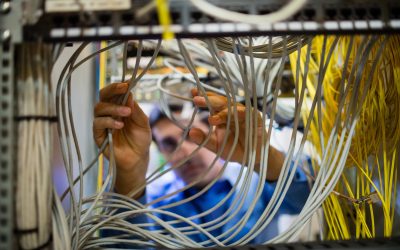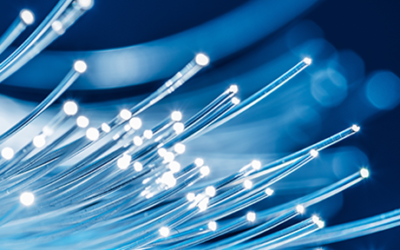Cabling in Healthcare – The arteries of a healthy network

Tags: data networks | fiber optic | hospital | Structured Cabling
We expect the right information to be in the hands of health professionals that need it, when they need it. It is no longer acceptable to be wasting time searching for patient records, x-ray scans, or patient details.
The future of healthcare is digital
Healthcare organizations realize that for information technology to have significant impact, fundamental practices and processes need to change. Using networks to help affect these changes is a strategy that healthcare enterprises are adopting. Networks improve customer satisfaction, increase employee efficiency, and provide better patient care.
With LANs, WANs and the Internet, proximity becomes irrelevant. From their homes, patients can use the Internet to discuss symptoms with clinicians via real-time consultations. Clinicians away from their offices can use the internet or their hospital’s intranet to review patient records, order prescriptions, and view test results and clinical images, such as X-rays and ultrasound. Organization-wide, employees become more self-sufficient with easy access to policies and procedures, employee benefits, internal communications, and procurement systems.
Healthcare IT applications
The network revolution has affected every aspect of the healthcare industry, from the way researchers conduct medical studies to the nature of the doctor-patient relationship. Perhaps its most significant effect has been on how people manage their own health and treatment.
The informed patient
Today, people use networks to access their personal medical records, research treatment options, and compare healthcare providers. Many websites publicize studies that evaluate the quality of hospitals, physicians, drugs, and treatments. Online psychotherapy and physician consultations are also available for those seeking medical opinions on their devices.
Medical information was the exclusive domain of physicians. Doctors held all the power when it came to decisions about patient care, and patients depended on physicians to educate them about their conditions and their options and to determine a course of treatment. Now, Patients are taking a stronger role in managing their own health and medical treatment. Armed with easily accessible information, patients today are active in asking questions, sharing their health information, and discussing their options.
The paperless doctor’s office
The healthcare industry is, at its core, a complicated information-management industry. Healthcare providers and pharmaceutical companies are automating the most cumbersome, administrative paperwork—converting formerly paper-based information to a format that can be easily stored, accessed, cross-referenced, and distributed.
Closer than the corner drugstore
Networks are creating entirely new classes of healthcare services. For example, the traditionally bricks-and-mortar pharmaceutical industry is rapidly gaining an online presence, and healthcare providers are capitalizing on this new sales and marketing channel by developing a host of specialty health services.
Alleviating the bottlenecks
With databases of medical articles, journals, and conference summaries, healthcare providers have access to the most current treatment information available from around the world. Networks also allow medical researchers to electronically collaborate and share large amounts of data.
Joining forces – sharing information
Networks have provided the medical community with greater access to information. In the past collaborating with medical professionals outside one’s community could be difficult, but now researchers can seamlessly collaborate and conduct more wide-ranging research projects.
Multimedia applications and telemedicine
Telecommunications systems, Internet data, and videoconferencing are fundamental to telemedicine projects that increase the quality of care and save lives. This triad of technologies drive telemedicine initiatives. Telemedicine gives doctors the power to consult other doctors at remote clinics hundreds of miles away without leaving their offices. In this manner, local facilities gain access to specialists and upgrades are achieved to the levels of care available at specialty centers. In addition, keeping staff up-to-date on advancements in medical treatment can be achieved via remote learning systems. These multimedia initiatives can be used to cut healthcare costs by making staff more efficient. However, multimedia applications and the need for increased bandwidth produce increased demands on traditional communication equipment.
The challenge in the operating rooms and radiology departments
The challenge confronting not only radiologists, but also the senior management of most healthcare institutions is how to meet the growing demand for fast, convenient access to diagnostic images, reports and prior exams throughout the healthcare enterprise. Simply put, referring physicians and radiologists want and need vital patient information on a real-time basis.
Diagnostic images, a core component of a patient’s medical record, are assuming a more pivotal role in healthcare delivery. Increasingly, medical images are used in the prevention—not just the diagnosis—of medical conditions. A rising number of specialists utilize medical images as a pre-surgical tool, with an image viewer stationed in or near the operating room where diagnostic images, captured digitally, can offer information superior to that provided by static film images. As healthcare institutions nationwide work to develop comprehensive electronic medical records, the inclusion of diagnostic images, and particularly prior studies for comparative purposes, represents a robust addition.
While distribution was the initial focus, today these systems also offer full Picture Archiving and Communications System (PACS) functionality, including radiology workstations, long-term archives, Health Information System (HIS) interfaces and standards-based seamless integration with the electronic medical record. The spread of structured cabling solutions, wired and wireless networking and device configurations and standards is overcoming any deterrents, making these solutions easy to implement in most hospital environments.
Cabling as a convergence enabler
A Structured Cabling Solution is a convergence enabler in the world of healthcare communications. Cabling is the arteries and veins of the wired and wireless network, enabling the organization to operate efficiently and reliably. Traditionally separate systems are coming closer together as new technologies are developed and deployed. New generations of multimedia communication systems are required to meet the demands of users.
Structured cabling solutions perform a role in transforming healthcare services within hospitals, nursing homes, home nursing, and outpatient services. Nurses consult a patient’s doctor via video network connectivity. Chronically ill patients can send test results and consult with their physicians on-line. Electrocardiograph (ECG) information can be transmitted over the hospital’s campus network. Hospital physicians transmit information from clinics to the emergency department for use. Physicians can make patient appraisals during patient treatment, based on information from cardiac, blood, and respiratory diagnostic devices.
With a high performance cabling infrastructure, other high-end applications like tele-surgery or virtual surgery become viable without the need for costly, single-purpose communications systems. The ability to exploit the high performance of solutions using high-speed networks has led to the creation of new environments. These environments will allow the user to “tele-immerse” in the remote environment or create a “tele-presence” for the patient.
Planning for a successful health care IT infrastructure
An enterprise-wide infrastructure strategy can help prevent department isolation—islands of communication—in a networked world. It is essential to involve the end users of the systems when creating a plan, as well as the support team. For example, the planning team for a patient monitoring system should include representatives from clinical engineering, information systems, telecommunications, nursing, physicians and operations.
The goal is to determine the overarching requirements for achieving long-term, enterprise-wide IT integration. This strategy will serve as the rules of the road for each department, guiding them in selecting appropriate and compatible technology. Infrastructure design is often dictated by the demands of the most critical systems, such as patient telemetry and telecommunications, which require high availability since they are used for real-time communication of patient vital signs and staff communications. Ancillary systems like data entry terminals for HIS charting can share the backbone that supports critical systems. It is very difficult, however, to add critical systems to an infrastructure that is not designed for high availability and performance.
Road to integration
With an integration road map, the planning team can identify mutual needs and select a common cabling infrastructure that supports multiple critical systems. Obviously, each department participating in the planning will have unique requirements and key issues. It is essential to understand and accommodate these issues. Number one priority for nursing may be system speed, while telemetry’s main concern is availability. Other requirements that ultimately drive the infrastructure design are: coverage (no. of outlets), individual application throughput and bandwidth needs, security, number of users and avoiding unplanned downtime.
First priority is choosing a platform that supports future enterprise communication needs. In other words, a hospital may only require 50 telemetry channels today, but anticipates doubling that in two years and expanding to areas not currently cabled-up. Make sure the infrastructure selected can adapt and grow in accordance with the hospital’s needs and trends.
Second priority is tying together islands of communication. This begins with selecting compatible technologies, but may also require expanded networking bandwidth to satisfy users’ demands for speed and functionality. Third, ensure that system availability is sufficient for mission-critical systems that cannot afford scheduled downtime or interruptions in service.
Protecting your investment
A cabling solution for a health care organization should follow three conceptual guidelines as a basis:
- The solution should be scalable—All sizes of health care entities should be able to comply with the standard.
- The solution should be comprehensive—The required solution should act as a unified system, not a series of “piecemeal” products that do not optimally work with each other.
- The solution should be technology-neutral—It should be able deliver now and in the future, because technology is constantly evolving. By dictating high performance system architectures and technologies, health care organizations can take advantage of state-of-the-art technologies and have the flexibility to choose the best solutions to fit their particular environments.
For copper cabling, Category 6 performance supports a data rate that is sufficient for many health care applications including patient charting, inventory management and medication delivery. Category 6A performance with its higher bandwidth will more easily enable new healthcare applications: viewing of MRIs and X-rays in radiology and beyond, streaming video for telemedicine applications in surgery or other specialized procedures.
For fiber cabling, mostly used in the building and campus backbone, but also maybe to locations of high performance scanning equipment, the decisions may be even more critical. Much of the data now flows across the network, and a high performance, reliable transmission medium is vital – the ‘life-blood’ of the system. With new high speed networks on the horizon, laser optimized multimode fiber (OM3/4) or single mode fibers must be deployed to give the network, a backbone to support it’s future.
As with most IT technologies, change does not happen overnight. From both the acquisition and resource perspectives, it’s cost prohibitive to make a wholesale switchover from one technology to another. Cabling is no different than other infrastructure investments; you want it to last. To make sure your investment won’t be obsolete in the short term, look for the following when purchasing a cabling infrastructure.
Choose an infrastructure with built-in support for multiple communication technologies. Category 6A and laser optimized multimode fiber (OM3/4/5) products gives a wider bandwidth available for use with future applications and lower complexity equipment. And new developments in LAN technologies are expected for years to come. You’ll want to be able to take advantage of higher speeds and new capabilities without having to deploy a completely new infrastructure. Avoid infrastructure solutions that offer no way to migrate or support the next standard.
These days, simply having information isn’t enough. You need to be able to access it, integrate it, and deliver it—and make it work for you. That’s why a reliable, robust network infrastructure is a real strategic advantage.
If you are interested in learning more about planning for networks, take a look at the Network Project Planning and Safety courses.

Written by James Donovan
You might also enjoy
FO Connector Contamination – A Constant Threat
Fiber optic communication most commonly works in duplex or multifiber transmission by transmitting light to a receiver in one direction on a fiber and receiving transmitted light back to a second receiver on the second fiber. Most engineers can understand that and...
Why Inspect and Clean Fiber Optic Connectors?
Inspecting and cleaning of fiber optic connectors during installation and when making any patching, is essential. Any contamination on a patch cord connector will be transferred through the coupler to the connector it is mated to. Even when testing fibers with a test...
Cleaning MPOs
MPO connectors should always be inspected with a scope before they are used, be that on a patch cord or a bulkhead. If they need to be cleaned, one-click cleaners are keyed to ensure the tip only fits one way onto the connectors and is able to clean both male and...


